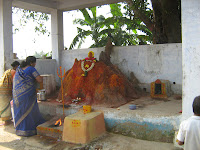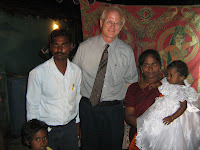 On this last day as a tourist/student in India, I went to Catholic Mass. Actually, I happened upon St. Mary’s Basilica, as daily mass was commencing, and I figured that if I could do puja in a sacred Hindu city, then maybe Christian Catholic mass was okay. At the service, I was blessed by the large and devout crowd of congregants, reciting the liturgy in full voice and kneeling in prayer on floor and in pew. Once again, at a Christian service in India, I saw the ways that religious traditions cross over into each other: Indian Christians bringing marigolds to offer to Jesus and Mary, devotees folding hands in the classic Hindu style, and acceptance of the host like Sikhs and Hindus accept the prasada following prayers. The service was actually my first attendance in a Catholic mass, I’m embarrassed to say (in World Religions courses, I often require students to do so). Perhaps, on this pilgrimage journey of my own, it is appropriate that I attended the mass here.
On this last day as a tourist/student in India, I went to Catholic Mass. Actually, I happened upon St. Mary’s Basilica, as daily mass was commencing, and I figured that if I could do puja in a sacred Hindu city, then maybe Christian Catholic mass was okay. At the service, I was blessed by the large and devout crowd of congregants, reciting the liturgy in full voice and kneeling in prayer on floor and in pew. Once again, at a Christian service in India, I saw the ways that religious traditions cross over into each other: Indian Christians bringing marigolds to offer to Jesus and Mary, devotees folding hands in the classic Hindu style, and acceptance of the host like Sikhs and Hindus accept the prasada following prayers. The service was actually my first attendance in a Catholic mass, I’m embarrassed to say (in World Religions courses, I often require students to do so). Perhaps, on this pilgrimage journey of my own, it is appropriate that I attended the mass here. Earlier I walked enthusiastically the few blocks from my hotel to visit the Bangalore Parsee Zoroastrian Temple. After visiting numerous Hindu shrines and temples, many Muslim mosques, some Christian churches, and after never being refused entry into a Sikh or Jain temple, I was surprised to be denied entry here, even to the porch area. Although a guard let me walk on the grounds, a priest soon emerged to lecture the guard and deny me conversation or entry. In the very security-conscious environment here in Bangalore, I will assume that language barriers, terrorism concerns, and perhaps a little theology are the bases for this abrupt refusal.
Earlier I walked enthusiastically the few blocks from my hotel to visit the Bangalore Parsee Zoroastrian Temple. After visiting numerous Hindu shrines and temples, many Muslim mosques, some Christian churches, and after never being refused entry into a Sikh or Jain temple, I was surprised to be denied entry here, even to the porch area. Although a guard let me walk on the grounds, a priest soon emerged to lecture the guard and deny me conversation or entry. In the very security-conscious environment here in Bangalore, I will assume that language barriers, terrorism concerns, and perhaps a little theology are the bases for this abrupt refusal.  Zoroastrians are known for a very strict works righteousness – God is a god who will punish fiercely, and there is no concept of mercy – as well as their reverence for their holy scriptures, the Avesta, which they deem to be the presence of God itself.
Zoroastrians are known for a very strict works righteousness – God is a god who will punish fiercely, and there is no concept of mercy – as well as their reverence for their holy scriptures, the Avesta, which they deem to be the presence of God itself.Bangalore is a large modern city, filled with buses and auto rickshaws, professional office buildings and technology firms, and several large parks.
 The photo is actually of a smaller neighborhood one, simply because my feet are tired of walking any more. Today I also stopped to have a shoe shine, the first on the trip (despite the incessant offerings in North India). I did have to wait about 15 minutes, as the cobbler repaired several sandals for a lady while negotiating a deal to make a new pair of dress shoes for another customer. I found his quick skilled handwork impressive, and his attitude of hard, positive work rewarding. He is one of thousands of similar shoe makers who line Indian streets with little stalls, laboring every day with an important skill. Likely there are similar workers in America, but once again I was reminded how much we do not see in the U.S., as well as how little we value the toil taken for something as simple as a pair of shoes.
The photo is actually of a smaller neighborhood one, simply because my feet are tired of walking any more. Today I also stopped to have a shoe shine, the first on the trip (despite the incessant offerings in North India). I did have to wait about 15 minutes, as the cobbler repaired several sandals for a lady while negotiating a deal to make a new pair of dress shoes for another customer. I found his quick skilled handwork impressive, and his attitude of hard, positive work rewarding. He is one of thousands of similar shoe makers who line Indian streets with little stalls, laboring every day with an important skill. Likely there are similar workers in America, but once again I was reminded how much we do not see in the U.S., as well as how little we value the toil taken for something as simple as a pair of shoes.The city has a large Muslim population, and I spoke with the imam at this very large Islamic
 center (worship mosque, community center, and educational facility). He was pleased that I could say a few Arabic phrases – Thanks be to God, In the name of God, Peace to you in the name of God – and I was pleased to hear of the community’s strong message against terrorism, as the sign reflects.
center (worship mosque, community center, and educational facility). He was pleased that I could say a few Arabic phrases – Thanks be to God, In the name of God, Peace to you in the name of God – and I was pleased to hear of the community’s strong message against terrorism, as the sign reflects.
While in Amritsar early on this trip, I was introduced to the writings of Khushwant Singh, one of India’s most widely read and controversial Sikhs. He had been active in the struggles between Sikhs, Hindus, and Muslims around the time of the creation of Pakistan, and he was important to the work of Gandi and others. He has an autobiography, entitled “Truth, Love, and a Little Malice.” I suppose that is both the goal and the reality for most of us. We want to speak and know the truth, we want to love and be loved, and, alas, we admit that we share thoughts of envy and anger. This online journal began as an attempt to think aloud about my India journey – to wrestle with matters of faith and spirituality, politics and tolerance, modernity and globalism. And I suppose, as an attempt at truth, love, as well as the calming of malice.
The journey has only begun.
slp

















































